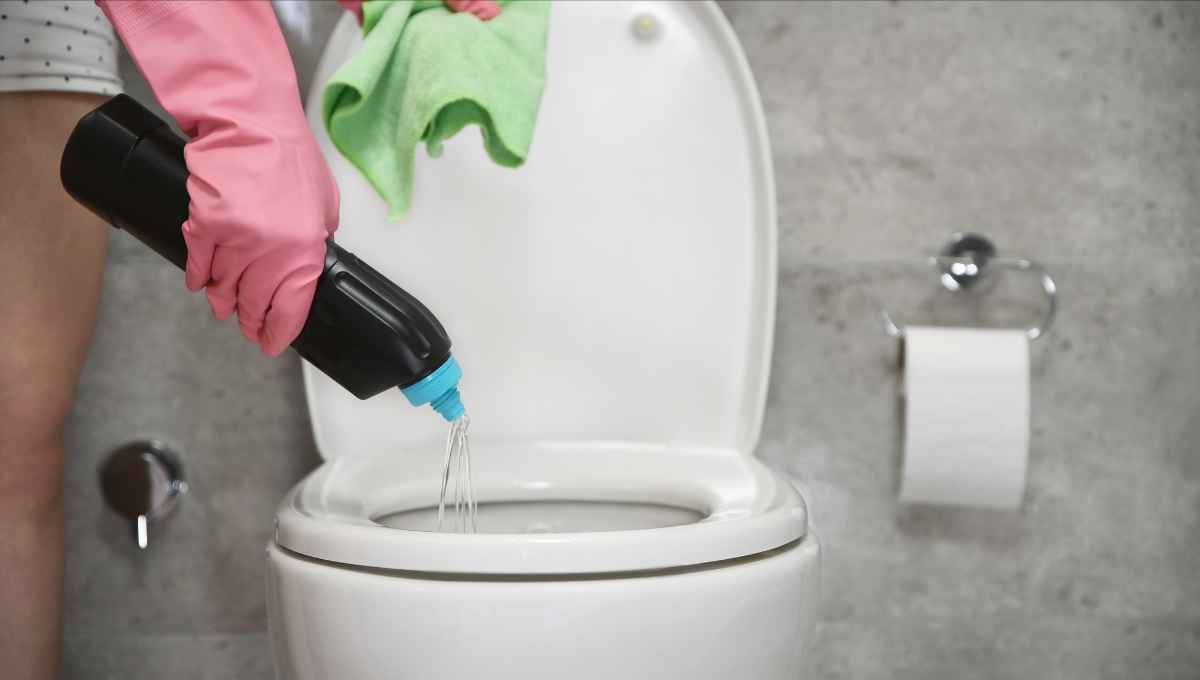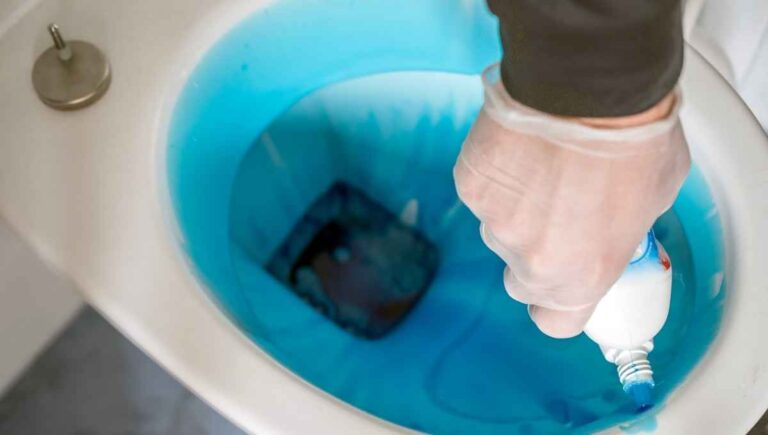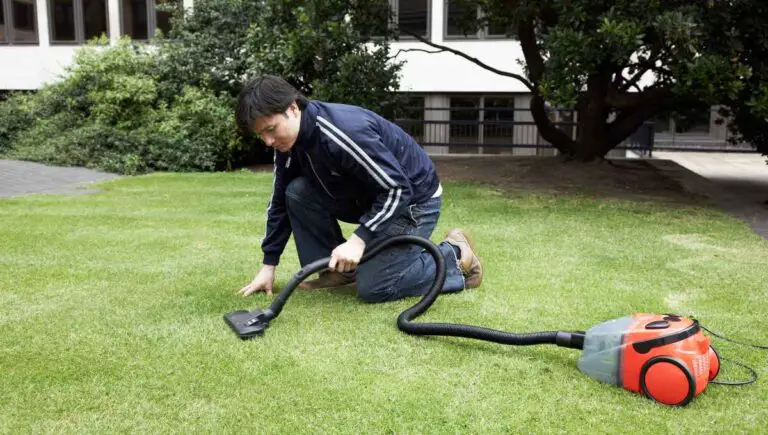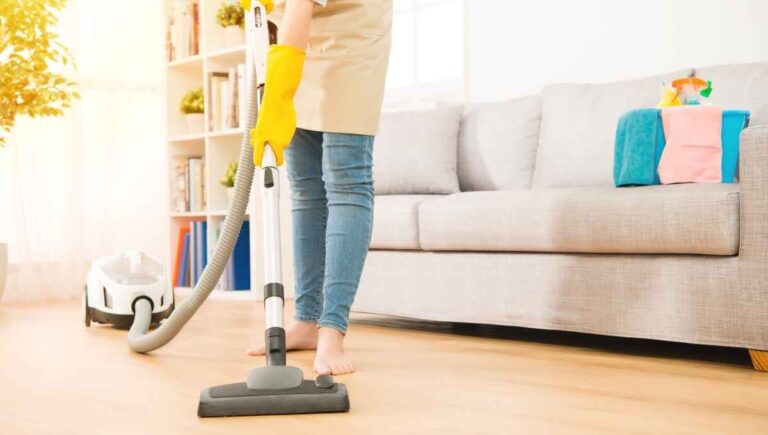Can You Flush Bleach Down the Toilet? (Try This Instead)

Bleach is a standard household cleaner that can be used for various tasks, from disinfecting surfaces to whitening clothes. However, when it comes to disposing of bleach, many people wonder if it’s safe to flush it down the toilet.
Flushing bleach down the toilet is not recommended. While bleach is a powerful disinfectant and can help keep your toilet bowl clean, it can also damage your plumbing system and harm the environment. Additionally, if bleach is mixed with other chemicals in the toilet or the sewer system, it can create toxic fumes or even explosions.
But what should you do with your leftover bleach instead? Don’t worry; we’ll discuss several safe and responsible ways to dispose of it in this post. Keep reading to learn more about properly disposing of bleach and keeping your home and environment safe.
This post contains affiliate links. This means Household Blogger may earn a commission should you make a purchase using any of our links. Please refer to our full affiliate disclosure policy for full details.
Here’s a Quick Pro Tip!
Here are some options you can easily find on Amazon:
1. Seventh Generation Chlorine-Free Bleach – A plant-based, biodegradable alternative to traditional bleach.
2. Clorox Colorload Non-Chlorine Bleach – A cruelty-free, plant-based bleach alternative that’s safe for septic systems.
3. Grab Green Natural Bleach Alternative Pods – A convenient, mess-free option that’s non-toxic and free of harsh chemicals.
Understanding the Basics of Toilet Cleaning with Bleach
Toilet cleaning is a necessary task that nobody enjoys, but it’s essential to maintain good hygiene and avoid unpleasant smells. One of the most commonly used cleaning products for the toilet is bleach.
However, many people are still determining if it is safe to flush bleach down the toilet. This section will explore the basics of toilet cleaning with bleach to help you understand its use and the precautions you should take.
What is Bleach and How Does it Work?
Bleach is a common household cleaning product that is used for a variety of purposes. It is a chemical solution made up of sodium hypochlorite and water, and its primary function is to disinfect and whiten surfaces. Sodium hypochlorite is a strong oxidizing agent that effectively kills bacteria, viruses, and other microorganisms.
When bleach comes in contact with water, it breaks down into several different components, including hypochlorous acid and hypochlorite ion. These two compounds are responsible for the disinfectant properties of bleach.
Hypochlorous acid is a strong oxidizing agent that can penetrate the cell walls of microorganisms and destroy their enzymes and proteins, eventually leading to their death. On the other hand, hypochlorite ion is less effective than hypochlorous acid but still contributes to the overall disinfectant properties of bleach.
Bleach is commonly used for cleaning and disinfecting surfaces such as floors, walls, and countertops. It is also used for whitening fabrics and removing stains. When it comes to toilet cleaning, bleach can be effective in removing tough stains and eliminating bacteria and germs.
However, using bleach properly and taking necessary precautions is essential to avoid any adverse environmental and human health effects.
Some have tried to use bleach as a dog shampoo; however, you should never use bleach on dogs. Bleach is a highly toxic chemical that can cause severe irritation, burns, and even damage to the eyes, skin, and respiratory system. When bleach comes into contact with a dog’s skin or fur, it can cause significant harm.
Advantages of Using Bleach for Toilet Cleaning
Bleach is a common household cleaning product that has been used for decades to clean toilets. Here are some of the advantages of using bleach for toilet cleaning:
- Kills germs and bacteria: Bleach is a powerful disinfectant that can kill germs and bacteria on contact. It can help eliminate harmful bacteria such as E. coli, salmonella, and other pathogens that can cause illness.
- Removes stains: Bleach is highly effective in removing stubborn stains from the toilet bowl, including rust, hard water stains, and other discolorations. It can leave your toilet bowl looking sparkling clean and fresh.
- Deodorizes: Bleach has a strong and distinct odor that can mask unpleasant odors and leave your bathroom smelling fresh and clean. It can help neutralize unpleasant smells that may be caused by urine, mold, or mildew.
- Affordable: Bleach is a cost-effective cleaning solution that is widely available in most grocery stores and supermarkets. It’s much cheaper than buying specialized toilet cleaners or hiring a professional cleaning service.
- Easy to use: Bleach is easy to use and requires no special training or equipment. Simply pour a small amount of bleach into the toilet bowl and scrub with a brush. It’s a quick and efficient way to keep your toilet clean and hygienic.
While bleach can be an effective toilet cleaner, using it properly and safely is important. Always follow the instructions on the label, wear gloves and protective clothing, and never mix bleach with other cleaning products, as it can create dangerous fumes.
It is generally recommended to use bleach to clean a toilet once or twice a week, depending on how frequently the toilet is used and how quickly it becomes dirty. Overuse of bleach can damage the toilet’s surface and cause discoloration, so it’s important not to use it excessively.
Preparing to Clean Your Toilet with Bleach
Before grabbing the bleach and starting to scrub, there is some important information you need to gather in order to protect not only your toilet seat but also the other people in your house.
Safety Considerations Before Cleaning with Bleach
Before using bleach to clean anything in your home, it’s important to understand the potential safety risks associated with this powerful cleaning agent. Firstly, it’s recommended to wear protective clothing such as gloves and goggles to prevent any accidental contact with your skin or eyes.
Bleach is incredibly strong when used at full strength, and it can be dangerous to breathe in the fumes. To reduce the risk of exposure to its fumes, it’s important to dilute bleach with water before using it to clean. A good rule of thumb is to mix one cup of bleach with one gallon of water.
It’s also crucial to never mix bleach with other cleaning products, as this can create dangerous chemical reactions. For example, mixing bleach with ammonia or vinegar can produce toxic chlorine gas. To ensure your safety, using bleach in a well-ventilated area is recommended. Open windows or use fans to circulate the air in the room.
The shelf life of bleach can vary depending on the storage conditions and the type of bleach. Generally, bleach has a shelf life of about six months to one year. After that time, the bleach may start to lose its effectiveness and potency, which could impact its ability to clean or disinfect effectively.
Additionally, if bleach is not stored properly, such as in high temperatures or direct sunlight, it can degrade more quickly and cause damage to the container or surrounding materials. Over time, bleach can also break down plastic containers, so storing it in a container made of glass or another non-reactive material is important.
Finally, keep bleach out of reach of children and pets, as it can be toxic if ingested. Store bleach in a secure location where it can’t be accidentally accessed. By following these safety considerations, you can safely use bleach to clean your home without putting yourself or others at risk.
Materials Needed for Toilet Cleaning with Bleach
When cleaning your toilet with bleach, it’s important to have the right materials on hand to ensure that the cleaning process is both effective and safe. Here are the materials that you’ll need:
- Bleach: Choose a bleach product that is suitable for cleaning toilets. Look for a bleach product that is labeled as “splashless” or “thick,” as these formulas are less likely to create splashes or spills that could cause harm.
- Rubber gloves: Protect your hands from the bleach by wearing rubber gloves. Make sure that the gloves are long enough to cover your wrists to prevent any bleach from splashing onto your skin.
- Protective Eyewear: Wear protective eyewear such as goggles or safety glasses to protect your eyes from bleach splatters.
- Toilet Brush: Use a toilet brush to scrub the inside of the bowl and remove any stains or buildup.
- Scrubbing Pad or Sponge: For the outside of the toilet use a scrubbing pad or sponge to clean the exterior surfaces of the toilet.
- Bucket: Fill a bucket with water to help dilute the bleach solution and to rinse off any cleaning tools after use.
With these materials on hand, you’ll be well-equipped to clean your toilet effectively and safely using bleach. Remember to always follow the safety considerations mentioned in the previous section to minimize any potential risks of using bleach.
Types of Bleach Products Suitable For Toilet Cleaning
When it comes to cleaning your toilet with bleach, you can choose from several types of bleach products. The most common type of bleach used for cleaning toilets is chlorine bleach.
It’s a strong disinfectant that can kill bacteria and viruses and effectively removes stains and buildup in the toilet bowl. However, it can also be harsh and potentially damaging to some surfaces, so following the instructions carefully is important.
Another type of bleach that you can use is oxygen bleach, also known as a color-safe bleach. This bleach is gentler and less likely to cause color fading, making it a good option if you have a colored toilet bowl or are concerned about the potential damage that chlorine bleach could cause to certain surfaces. However, it may be less effective than chlorine bleach at removing tough stains.
Finally, there’s enzyme bleach, which is made from natural enzymes that break down organic matter and stains in the toilet bowl. It’s a good option if you’re looking for a more eco-friendly and natural alternative to chlorine bleach. However, it may not be as effective at disinfecting or removing tough stains.
Regardless of which type of bleach product you choose, make sure to read and follow the instructions carefully, and always use bleach in a well-ventilated area and wear protective clothing and eyewear.
You might also enjoy our post on Whether Bleach Dissolves Toilet Paper
Step-by-Step Guide for Cleaning Your Toilet with Bleach
Step 1: Prepare Your Toilet for Cleaning
Before you begin cleaning your toilet with bleach, properly preparing the area is essential. The first step is wearing gloves to protect your skin from harm. Next, open the windows and doors or turn on the exhaust fan to ventilate the area. This is important because bleach can produce strong fumes that can be harmful if inhaled.
After that, remove any excess debris from the bowl. You can use a toilet brush or a plunger to remove any solid waste or debris from the bowl. This step will help to make the cleaning process more effective.
If desired, you can apply toilet bowl cleaner to the inside of the bowl before adding bleach. This step can help to remove stubborn stains and make it easier to clean the toilet. Be sure to follow the instructions on the cleaner’s label carefully.
Next, gather your supplies. You’ll need a few things to clean your toilet effectively, including a toilet brush, bleach, a bucket, and a pair of rubber gloves. Once you have all the necessary supplies, start by flushing the toilet to wet the inside of the bowl and loosen any remaining debris or dirt.
Now, it’s time to add the bleach to the toilet bowl.
Step 2: Dilute the Bleach Solution
Now that you have prepared your toilet for cleaning, it’s time to mix the bleach solution. Bleach is a powerful disinfectant but can also be harmful if used incorrectly. To avoid any potential damage to your toilet or harm to yourself, diluting the bleach solution properly is crucial.
To do this, fill a bucket with one gallon of cold water. Next, add one cup of bleach to the water and stir well. It’s important to note that you should never mix bleach with any other cleaning agents, such as ammonia or vinegar. Doing so can produce harmful fumes and cause a chemical reaction that can be dangerous.
Adjusting The Bleach Solution to Fit Your Cleaning Needs
While a standard bleach solution can work for most cleaning tasks, there may be times when you need to adjust the bleach concentration to achieve the desired results. Here are a few tips for adjusting bleach concentration for specific cleaning needs:
- For light cleaning: If you’re just doing a quick clean and don’t have any tough stains or marks to remove, you can use a lower bleach concentration. Mix ½ cup of bleach with one gallon of water to create a milder solution.
- For heavy cleaning: If your toilet has stubborn stains or marks that are difficult to remove, you may need to use a stronger bleach solution. Mix one cup of bleach with one gallon of water to create a more potent solution. However, be cautious when using a higher bleach concentration, as it can be harsh on surfaces and can cause damage if not used properly.
- For disinfecting: If you’re looking to disinfect your toilet, you’ll need to use a bleach solution that is strong enough to kill bacteria and viruses. Mix one cup of bleach with one gallon of water to create a potent disinfectant solution. Be sure to let the solution sit for at least ten minutes to ensure proper disinfection.
Remember, it’s essential always to read the instructions on the bleach bottle and follow the manufacturer’s recommendations for diluting the bleach. Adjusting the bleach concentration can be effective, but it can also be dangerous if not done correctly.
Step 3: Apply the Bleach Solution to Your Toilet
Once you have diluted the bleach solution, you can now apply it to your toilet. The next step is to pour the solution into the toilet bowl. Be sure to pour the bleach solution carefully so it does not splash on your skin or clothing.
It’s essential to make sure that you cover all areas of the bowl with the bleach solution. To reach all areas of the bowl, use a toilet brush to spread the solution around the inside of the bowl. Make sure to get under the rim and into the corners.
Be sure to wear gloves when applying the bleach solution to protect your skin. Avoid splashing the solution, as it can cause skin irritation and damage to your clothing.
Step 4: Scrub Your Toilet with a Toilet Brush
Begin by scrubbing from the top of the bowl and working your way down. Use a toilet brush to scrub away any stains or buildup, focusing on areas that have a lot of buildup or are harder to reach. It’s crucial to ensure that you scrub all areas of the bowl thoroughly, including under the rim and around the edges.
When scrubbing the bowl, make sure to apply enough pressure to remove any tough stains or buildup. However, be careful not to use too much pressure, as this can damage the surface of the toilet bowl.
For more stubborn stains or buildup, you may need to use more bleach solution or allow the solution to sit in the bowl for a long time before scrubbing. After scrubbing the entire bowl, let the bleach solution sit for a few minutes before flushing the toilet. This will ensure that any remaining bacteria or germs are killed off.
Step 5: Let the Bleach Solution Sit for a Few Minutes
After scrubbing the toilet bowl with a toilet brush, it’s essential to let the bleach solution sit and disinfect the toilet for a few minutes. The amount of time you should let the solution sit will depend on the concentration of bleach and the severity of the stains or buildup.
For optimal results, it’s recommended that you let the bleach solution sit in the toilet bowl for at least ten minutes. This will give the solution enough time to disinfect the toilet, killing any remaining bacteria or germs.
However, be careful not to leave the bleach solution sitting in the toilet bowl for too long, as this can cause issues such as discoloration or damage to the toilet bowl surface. If you notice any discoloration or damage after using bleach, consider reducing the amount of bleach solution or shortening the waiting time.
Step 6: Flush the Toilet and Rinse the Bowl
After letting the bleach solution sit for the recommended time, it’s time to flush the toilet to remove the solution and any debris from the bowl. Flush the toilet multiple times to ensure that all of the bleach solution is rinsed away and there is no residue left in the bowl.
Once the bleach solution and debris have been flushed away, it’s time to give the bowl a final rinse. Using a clean cup or bucket, pour clean water into the bowl and use a toilet brush to scrub away any remaining residue.
Flush the toilet again to remove the water and any remaining debris or residue. Repeat the rinsing and flushing process until the bowl is completely clean and free of any bleach or debris.
By following these steps, you’ll be able to clean and disinfect your toilet bowl thoroughly using the bleach solution. Remember to always handle bleach carefully, wear protective gloves, and ensure the area is well-ventilated while cleaning.
You might also enjoy our post on Whether You Can Flush Baby Wipes Down The Toilet
Tips for Safe and Effective Toilet Cleaning with Bleach
When it comes to cleaning the toilet, bleach is a go-to cleaning agent for many people. It effectively removes stains and kills germs and is also readily available and affordable. However, using bleach to clean the toilet can be dangerous if not done properly.
In this section, we’ll go over some important tips for safe and effective toilet cleaning with bleach, so you can keep your toilet clean and germ-free without endangering your health or damaging your toilet.
Dos and Don’ts of Toilet Cleaning with Bleach
Toilet cleaning is a task many people dread, but keeping your bathroom clean and hygienic is necessary. Bleach is a commonly used cleaning product that effectively kills germs and removes stains. However, there are certain dos and don’ts that you should keep in mind when cleaning your toilet with bleach.
Proper disposal of bleach products and cleaning tools:
- Always read the label before using any bleaching product. The label will provide you with important information about how to use the product safely and properly dispose of it.
- When you’re done using a bleach product, make sure to dispose of it according to the label instructions. Don’t pour bleach down the drain or toilet, as this can cause damage to the plumbing system and harm the environment. Instead, take it to a hazardous waste disposal facility or contact your local waste management department for guidance.
- When cleaning with bleach, make sure to use gloves and protective eyewear to avoid any accidental contact with your skin or eyes. After use, wash your hands and cleaning tools thoroughly with soap and water.
Common mistakes to avoid when cleaning with bleach:
- Never mix bleach with other cleaning products, such as ammonia or vinegar. This can create toxic fumes that can be harmful to your health.
- Don’t use bleach on colored fabrics or surfaces, as it can cause discoloration or damage. Stick to using bleach on white or colorfast fabrics and surfaces.
- Don’t use too much bleach. Using too much bleach can cause damage to the toilet bowl or the pipes. Always follow the label instructions and use the recommended amount of bleach.
- Don’t leave bleach in the toilet bowl for too long. Bleach can be corrosive, and leaving it in the toilet bowl for too long can cause damage. Follow the label instructions on how long to leave the bleach in the toilet bowl before flushing it away.
By following these dos and don’ts, you can effectively clean your toilet with bleach without causing harm to yourself, your plumbing system, or the environment. Remember to always read the label instructions and dispose of bleach products and cleaning tools properly.
Best Practices for Handling and Storing Bleach
Bleach is a powerful cleaning agent that can be used for various purposes, but it’s important to handle and store it safely to avoid accidents or injuries. When storing bleach products, always make sure to store them in a cool, dry, and well-ventilated area away from direct sunlight to avoid losing their effectiveness and potency.
Additionally, it’s important to keep bleach out of reach of children and pets by storing it in a locked cabinet or high shelf to prevent accidental ingestion or contact. Avoid storing bleach near other cleaning products, especially ammonia or acids, to prevent mixing that can create toxic fumes harmful to your health. Ensure the container is tightly closed after each use to prevent spills and leaks.
When handling and using bleach around pets and children, it’s important to take certain precautions to ensure their safety. Always wear gloves and protective eyewear when handling bleach to avoid accidental contact with your skin or eyes.
If possible, avoid using bleach around pets and children, and keep them out of the room while cleaning with bleach. Make sure the area is well-ventilated to reduce their exposure to fumes.
Never mix bleach with other cleaning products, especially those containing ammonia or acids, as this can create toxic fumes that can be harmful to both pets and children. Rinse surfaces thoroughly with water after using bleach to remove any residue that could harm pets or children who may come into contact with the surface.
By following these best practices, you can safely handle and store bleach products to ensure that they are effective when you need to use them. Always read the label instructions carefully and follow them closely to avoid accidents and injuries.
With these guidelines in mind, you can use bleach effectively and safely in your home without any negative impact on your family, pets, or the environment.
Alternative Cleaning Solutions for Your Toilet
If you’re concerned about flushing bleach down the toilet, you can use alternative cleaning solutions to keep your toilet clean and fresh. One option is to use natural and eco-friendly cleaning agents.
White vinegar is a popular natural cleaning solution that can be used to clean toilets. Simply pour a cup of vinegar into the toilet bowl and let it sit for 30 minutes before scrubbing it with a toilet brush.
Baking soda is another option that can be used in combination with vinegar. Sprinkle baking soda into the toilet bowl, followed by vinegar, and let it sit for 30 minutes before scrubbing.
Another natural option is essential oils. Tea tree oil and eucalyptus oil have antibacterial properties and can be added to your toilet bowl cleaning routine. Mix a few drops of essential oil with water and spray the solution into the toilet bowl before scrubbing. This will leave your toilet smelling fresh and clean.
For those who prefer commercial cleaning products, plenty of options are also available. Many cleaning brands offer bleach-free toilet bowl cleaners that effectively remove stains and kill bacteria.
These cleaners usually contain citric acid, hydrogen peroxide, or other non-toxic ingredients. Some brands also offer eco-friendly options made with natural ingredients and safe for septic systems.
When choosing a commercial cleaning product, make sure to read the label and check for any harmful chemicals or ingredients. Avoid products that contain chlorine bleach, ammonia, or phosphates, as these can be harmful to the environment and your septic system.
You might also enjoy our post on Whether You Can Flush Kitty Litter Down The Toilet
Final Thoughts
In conclusion, flushing bleach down the toilet is not recommended. While it may seem like a convenient way to dispose of bleach, it can cause significant damage to your plumbing system and the environment. Bleach can corrode pipes and cause blockages, leading to costly repairs.
Additionally, the chemicals in bleach can harm the beneficial bacteria in septic systems, disrupting the natural balance and potentially leading to system failure. To avoid these problems, it’s best to dispose of bleach properly by diluting it with water, pouring it down the drain, or taking it to a hazardous waste disposal facility.









